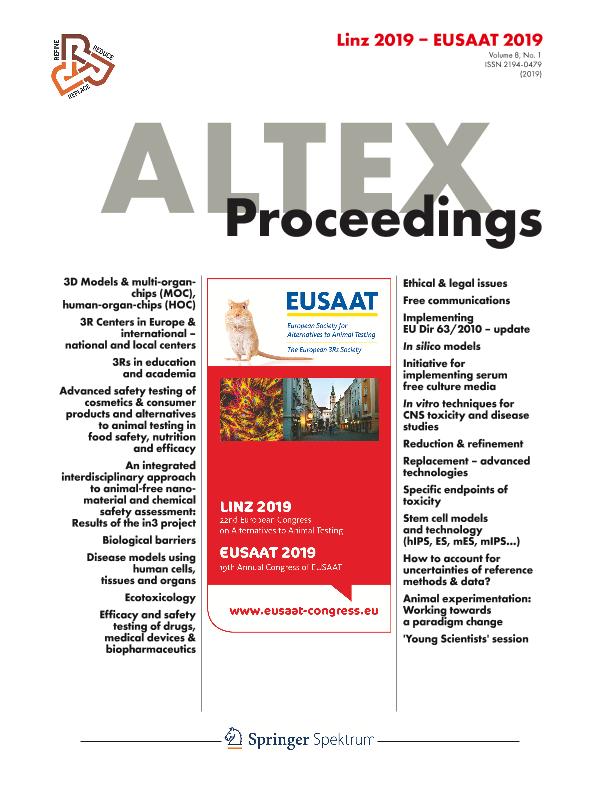Mostrar el registro sencillo del ítem
dc.contributor.author
Schilrreff, Priscila

dc.contributor.author
Zoschke, Christian
dc.contributor.author
Morilla, María José

dc.contributor.author
Romero, Eder Lilia

dc.contributor.author
Schafer Korting, Monika
dc.date.available
2022-06-22T13:19:47Z
dc.date.issued
2019
dc.identifier.citation
A reconstructed human skin model containing macrophages to set up a delayed wound healing model of cutaneous leishmaniasis; 22nd European 3Rs Congress; 9th European Society for Alternatives to Animal Testing Congress; Linz; Austria; 2019; 186-186
dc.identifier.issn
2194-0479
dc.identifier.uri
http://hdl.handle.net/11336/160167
dc.description.abstract
Cutaneous leishmaniasis (CL) is a vector-borne neglected disease caused by protozoan parasites of the genus Leishmania. Disfiguring and socially stigmatizing skin lesions develop at the bite site of the parasite-infected female sand fly [1]. Tissue damage and disease in CL are primarily caused by an excessive host immune response against the intracellular infection of dermal macrophages [2]. The dermal lesions persist for months or even years, but eventually heal on their own [3]. Treatment of CL is problematic, as long series of painful injections with the toxic pentavalent antimonials remain the standard therapy [1] and lesions are left alone to self-cure with the risk of secondary bacterial or fungal infection. New therapies for CL and CL lesions are urgently needed. Therefore, realistic CL lesion models are essential as a predictive experimental platform to identify more effective topical strategies. To that aim we integrated for the first time in vitro-generated M1 polarized macrophages differentiated from the human monocytic THP‐1 cell line into reconstructed human skin (RHS). THP-1 derived macrophages were localized in the RHS dermal compartment and distributed homogenously in accordance with native human skin. Standardized circular wounds were made with a 18 gauge blunt tip needle or by punch biopsy. In order to impair wound healing, wounded RHS was stimulated with intradermal application (for needles) or drops (for punch wounds) of IFN-γ in combination with LPS and/or hydrocortisone. Wound healing was monitored on days 1, 3 and 7 after wounding by histological examination of RHS. Immunohistochemical (Ki67, K14, tenascin-C, laminin 5, α‐SMA) and pro-inflamma ory cytokine analyses were performed pre‐ and post‐skin wound and stimulation, to increase the characterization of the model and to assess the effects of IFN-γ, LPS and hydrocortisone in wound healing RHS models. Early in healing, IFN-γ-LPS-hydrocortisone wounds displayed reduced proliferation and re-epithelialisation and heightened inf lammatory response compared with control wounds. H&Estained sections showed increased epidermal thickness and a lack of dermal epidermal junction in the wound zone. In summary, we integrated functional THP-1 derived macrophages into RHS and induced a delayed wound healing to provide a unique experimental test platform to evaluate the effects of new topical treatments.
dc.format
application/pdf
dc.language.iso
eng
dc.publisher
Springer

dc.rights
info:eu-repo/semantics/openAccess
dc.rights.uri
https://creativecommons.org/licenses/by-nc-sa/2.5/ar/
dc.subject
RECONSTRUCTED HUMAN SKIN
dc.subject
ULCER
dc.subject
MACROPHAGES
dc.subject
CUTANEOUS LEISHMANIASIS
dc.subject.classification
Tecnologías que involucran la manipulación de células, tejidos, órganos o todo el organismo

dc.subject.classification
Biotecnología de la Salud

dc.subject.classification
CIENCIAS MÉDICAS Y DE LA SALUD

dc.title
A reconstructed human skin model containing macrophages to set up a delayed wound healing model of cutaneous leishmaniasis
dc.type
info:eu-repo/semantics/publishedVersion
dc.type
info:eu-repo/semantics/conferenceObject
dc.type
info:ar-repo/semantics/documento de conferencia
dc.date.updated
2022-06-21T18:16:36Z
dc.journal.volume
8
dc.journal.number
1
dc.journal.pagination
186-186
dc.journal.pais
Alemania

dc.journal.ciudad
Berlín
dc.description.fil
Fil: Schilrreff, Priscila. Consejo Nacional de Investigaciones Científicas y Técnicas; Argentina. Universidad Nacional de Quilmes; Argentina
dc.description.fil
Fil: Zoschke, Christian. Freie Universität Berlin; Alemania
dc.description.fil
Fil: Morilla, María José. Consejo Nacional de Investigaciones Científicas y Técnicas; Argentina. Universidad Nacional de Quilmes; Argentina
dc.description.fil
Fil: Romero, Eder Lilia. Consejo Nacional de Investigaciones Científicas y Técnicas; Argentina. Universidad Nacional de Quilmes; Argentina
dc.description.fil
Fil: Schafer Korting, Monika. Freie Universität Berlin; Alemania
dc.relation.alternativeid
info:eu-repo/semantics/altIdentifier/url/https://proceedings.altex.org/?2019-01
dc.conicet.rol
Autor

dc.conicet.rol
Autor

dc.conicet.rol
Autor

dc.conicet.rol
Autor

dc.conicet.rol
Autor

dc.coverage
Internacional
dc.type.subtype
Congreso
dc.description.nombreEvento
22nd European 3Rs Congress; 9th European Society for Alternatives to Animal Testing Congress
dc.date.evento
2019-10-10
dc.description.ciudadEvento
Linz
dc.description.paisEvento
Austria

dc.type.publicacion
Journal
dc.description.institucionOrganizadora
European Society for Alternatives to Animal Testing
dc.source.revista
Altex Proceedings
dc.date.eventoHasta
2019-10-13
dc.type
Congreso
Archivos asociados
